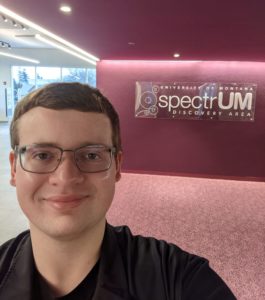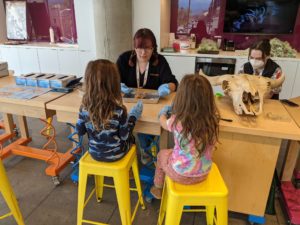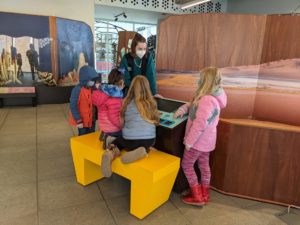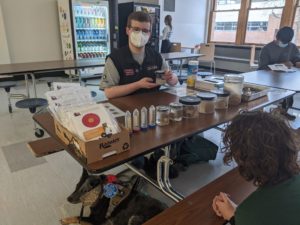Witnessing Inspiration Bloom By Jonathan Carter

As I enter the penultimate month of my service year, I would like to take a moment to pause and reflect on my experience so far. I’ve found my community impact can be a bit more challenging to measure than that of my fellow cohort members. While their high school and college students are working hard on grades and applications, my zero- to ten-year-old audience is concerned with simply having fun (and learning new things!) at the museum. Ultimately, smiles and inspiration are trickier to report than in-kind resources and scholarships earned. Some of my favorite visitor comments I have overheard include “I want to take science class here instead of at school.”, “This is my favorite place. If this place is closed, I just want to go home.”, “How come I didn’t have this when I was a kid?”, and “There’s so much to see and do. Science is amazing!” In that spirit, I will now share publicly some of the stories that have moved and stayed with me the most during the past ten months.

The thing I love most about my AmeriCorps service is seeing small children express excitement about science and knowing that the exhibits and activities at spectrUM have encouraged and nurtured that interest. The Missoula Butterfly House and Insectarium visits the museum nearly every Thursday and it is a joy to watch kids hold and interact with the (friendly) bugs. Meanwhile, a black widow spider and other potentially unfriendly bugs remain safely in their enclosures. The blue death-feigning beetle is a popular guest due to its eponymous defense strategy of rolling over and pretending to be dead (I learned spiders and other predators usually prefer to attack live prey). Multiple tarantulas dropped by to celebrate Halloween and visitors (and spectrUM staff) were surprised by their apparent inactivity. Despite their portrayal in pop culture, the tarantulas were perfectly content to stand still and wait to ambush any crickets that were unfortunate enough to wander too close. Numerous children look forward to Bug Day at the Discovery Bench and being tickled by the legs of a millipede or Madagascar hissing cockroach curious to explore their warm hands.
In late January, spectrUM welcomed Life on the Edge, “a new touring exhibition exploring extreme environments on Earth and expanding awareness of the possibilities for life in our Solar System and beyond. In Life on the Edge, visitors will discover that life is hidden in plain sight by exploring a colorful microbial colony, further understand the importance of our missions to Mars, learn about rover tests in the Atacama Desert, and detect what light reveals in faraway places using spectroscopy.” This phenomenal collection of astrobiology exhibits was created by Ithaca, New York’s Sciencenter in partnership with the Spacecraft Planetary Image Facility and through the generous support of NASA. The great enthusiasm of the public for this exhibition was truly uplifting, and it invigorated my passion for supporting science education in my adopted community. On opening day, one child was so excited that he repeatedly jumped up and down and banged on our glass doors. As I carefully opened those doors, he cheered loudly and quickly raced inside to explore the brand-new museum floor. A substantial portion of spectrUM’s audience is younger than five and while they may not have grasped the particulars of astrobiology, they were still delighted by the giant tube worms that rose and fell on their own. I continue to field questions about the absence of the popular programmable rover, which is now engaging families at a science museum somewhere in Wyoming.

One of the most exciting things to happen during my service in February was the launch of Science Zone, spectrUM’s new after-school program in collaboration with the Flagship Program at Hellgate High School. I transported science activities to Hellgate’s cafeteria six times alongside Chase Campbell, spectrUM’s second AmeriCorps Leader. During our first visit on February 16th, we brought a squid dissection, self-contained science kits, and the museum’s collection of preserved animal brains. Science Zone was off to an auspicious start, with approximately 25 students stopping by our table to check out the dissected squid and assorted brains in jars. Students (perhaps those with stronger stomachs) had the opportunity to don gloves to touch and explore the squid’s squishy internal organs. As we say at the Discovery Bench, this is not gross—it’s cool! Our other activities included self-inflating balloons, colorful slime, and Cubelets robot blocks. Chase and I enjoyed interacting with high school students since young adults of that age often consider themselves too cool to be seen at a children’s science museum. I am proud to have initiated spectrUM’s relationship with Flagship and I am excited to watch this partnership grow in subsequent years.

A major highlight of March (and of my service year overall!) was the 13th Annual ServeMontana Symposium in Helena. It was the first large event I had attended in more than two years, and it helped me realize just how much I had missed the communal experience of sharing a (physical) space with a significant number of people who share my mission and purpose. It was rewarding to facilitate the regional networking session and learn more about AmeriCorps members in other programs who also serve Missoula. Listening to the speakers and presentations, reconnecting with my cohort in person, and exploring a new corner of Montana all rejuvenated and inspired me as I returned to my service at spectrUM.
The moments I find especially resonant at the museum are those in which a child is fascinated by and becomes engrossed in one of our science activities. During one memorable interaction in March, a young girl remained at the Discovery Bench for at least 30 minutes so she could hold a pet ball python that belongs to one of my AmeriCorps team members. She eventually left the museum with her father, and they returned soon after with several children’s books about the visiting snake’s species. It was heartwarming to witness her interest in snakes develop seemingly on the spot as she asked to hold the reptile once again. The young girl’s pink vest proclaimed that she is a “JUNIOR RANGER,” and her curiosity and enthusiasm certainly proved her worthy of that title.

A special memory from my service in May was an impromptu liquid nitrogen demonstration that took place on Saturday the 21st. Following a liquid nitrogen birthday party, spectrUM team members decided to use up the rest of our supply in a rare surprise demo. A crowd of children and parents quickly gathered at the Discovery Bench to take part in the fun. We first froze balloons and watched as the air inside seemingly disappeared. The balloons shrunk dramatically as the oxygen and nitrogen gases contracted and even changed their state to become liquids. Liquid nitrogen is that cold! Six fully inflated balloons were able to fit into a single bowl through the power of condensation. Once the balloons were no longer in contact with the liquid nitrogen, they quickly expanded back to normal with the help of children blowing on the shriveled balloons. Another popular activity is trying Cheetos and marshmallows after they were submerged in liquid nitrogen. Spoiler alert: frozen Cheetos cause “smoke” to escape through the eater’s mouth and nose. Kids sometimes pretend they are ferocious fire-breathing dragons—if they aren’t unnerved by the effect. When frozen, marshmallows become crunchier and lose much of their characteristic texture. Our visitors had a blast and eagerly ate all of the snacks that we prepared.
Witnessing young people’s enthusiasm for science growing right in front of me is truly a soul-stirring experience. I moved west to Montana after college because I firmly believe in the power of education and young people to change the world. Diversity and inclusion are cornerstones of my professional life and I take seriously my responsibility to advocate for students from all backgrounds. In these challenging times, I identify strongly with the tenets of the AmeriCorps Pledge: acting in the face of apathy, seeking common ground in the face of conflict, and persevering in the face of adversity. These are values that I live by every day as my service enriches my community and affirms that each child has the potential to be a scientist.
 Blog
Blog